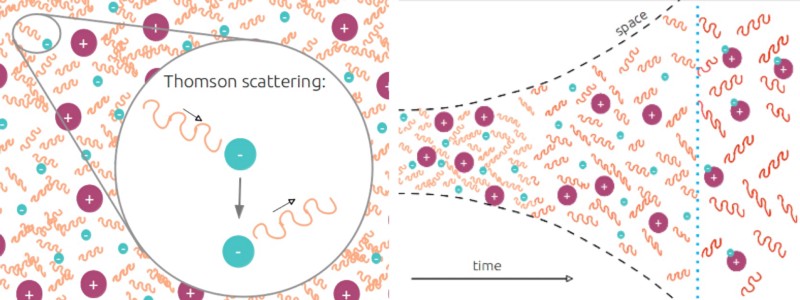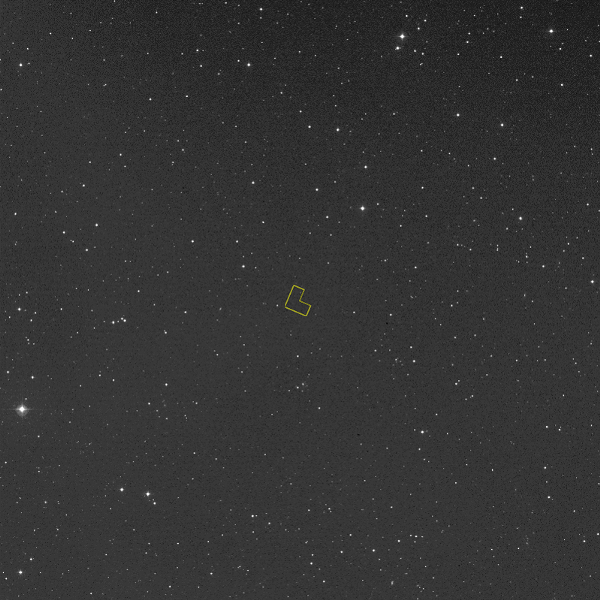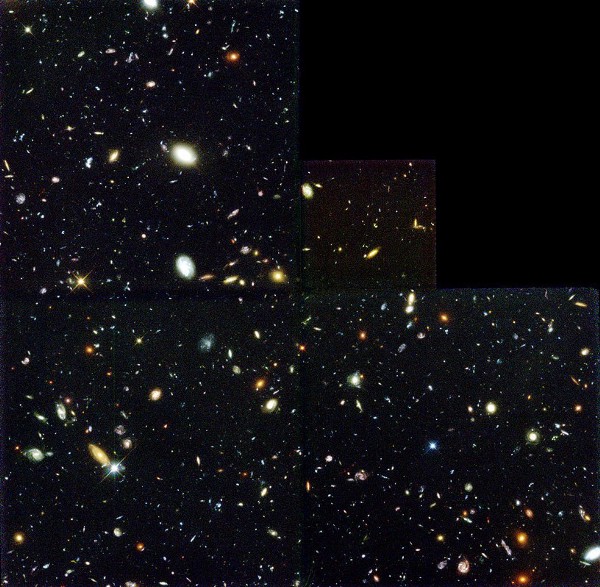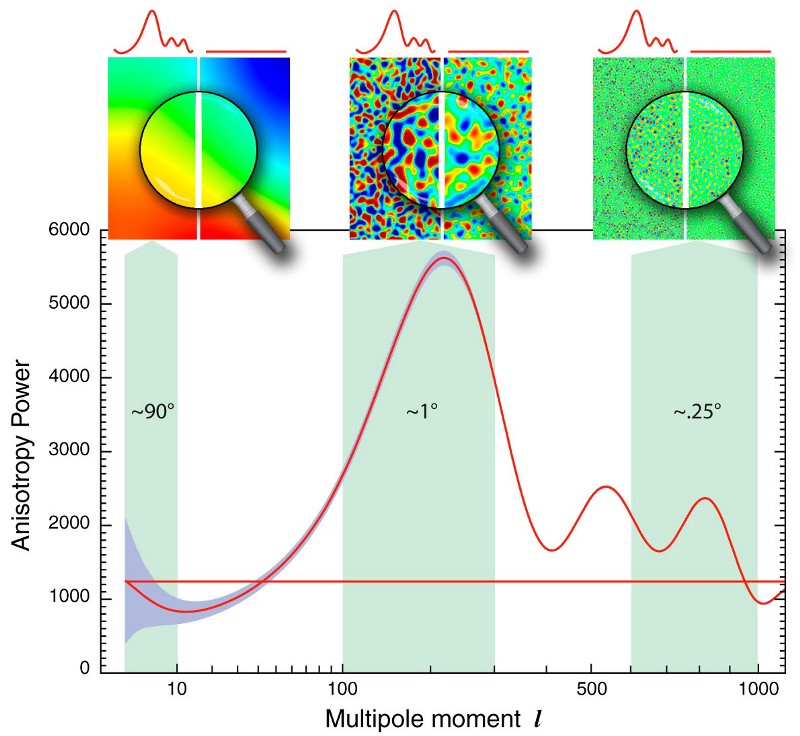Ask Ethan # 85: Hubble vs. the Big Bang
How do we know that fluctuations in the cosmic microwave background radiation (CMFR) are not contaminated by what opens the telescope to them. Hubble?
Quietly, one by one, on the endless sky meadows
Angelic flowers bloom beautiful stars
- Longfellow
Celebrating the 25th anniversary of the launch of the space telescope. It was natural for Hubble to choose from your questions a letter from Gerard, who drew attention to two things that you might consider unrelated to each other, although they are related. He is asking:
Scientists talk about the almost perfect uniformity of the KMFI. How do they know that the measured discrepancies in uniformity do not arise due to the lack of good corrections for galaxies in the field of view of telescopes measuring radiation?
You may think that this has nothing to do with Hubble, but it is not. Let's return to the beginning of the story and follow its development.

Hot Big Bang begins with a hot and dense soup of particles, antiparticles and radiation at incredibly high temperatures. It is almost perfectly smooth and uniform, but not quite. Inflation, a phenomenon that preceded and led to the Big Bang, stretched tiny quantum fluctuations that constantly occur across the entire space of the Universe, and created a set of regions of high and low density.
In addition, this hot and dense universe is expanding. Gravity works for universal compression and attracts more and more matter and energy to regions with higher density and tries to collapse the Universe back. The same struggle of gravity with expansion, in parallel with the cooling of the Universe (since expansion affects not only the amount of matter per unit volume) stretches the wavelengths of the existing light.
')

After the Universe has cooled enough for breaking symmetries, and the particles have mass, the extra particle / antiparticle pairs are annihilated, protons with neutrons form stable atomic nuclei and, finally, you have the opportunity to create stable neutral atoms, since the residual radiation no longer has energy sufficient for re-ionization of atoms. At this point, the photons remaining from the Big Bang are able to travel in a straight line, as free electrons become bound.

This radiation is almost uniform. But the radiation we see will be uniform, but not quite. Inflation not only created regions with different densities, but on certain scales (more often on small ones) gravity also worked on increasing (or decreasing on other scales, which affects the interaction with radiation) the difference between regions with increased and decreased density.
So why, although the radiation turned out to be homogeneous, we don’t see it that way?

Recall the most important idea introduced by Einsteinian GR: space is bent in the presence of matter and energy. If we take a region of space with a higher density - more matter, more energy - the space in it will be curved more strongly and any light entering this region will move to the blue part of the spectrum, and any light coming out of it will move to the red part.
And if the whole world was originally of the same temperature, but some regions turned out to be more or less dense, what would this mean for the light that came in and then left such a region and came into our eyes?

This means that denser regions will appear colder due to higher gravitational redshifts, while less dense regions will appear more hot, due to lower gravitational redshifts. This is called the Sachs-Wolf effect.
When we study the best available photographs of the “childhood of the Universe”, that is, the fluctuations in the KMFI, we see them exactly what we expect: the cold areas correspond to the regions with higher density that, due to gravity, grow in areas rich in stars, galaxies and clusters. On the contrary, hot areas - regions with lower density, which on average will give all their matter to the surrounding denser regions and will be less than the average number of stars, galaxies and clusters in them.

What about all the stars, galaxies and clusters? Of course, they can lead to the same results: the gravitational shift in the red part of the spectrum after the prehistoric radiation scoops out of the gravity wells. After all, as Hubble teaches us, there are a lot of galaxies in the Universe, even in those places of the cosmos in which they cannot be seen without a very long exposure.


But by itself, this phenomenon will not be a problem. The photons experienced a blue shift when they "fell" into the galaxy and only then experienced a red shift by the same amount, having chosen from there.
There are two phenomena that can change the photon energy in such cases, and both have an impact on the CMBR:
- Gas in galaxies and clusters, due to temperature and displacement, can lead to a change in temperature in the CMBR. This phenomenon is known as the Sunyaev-Zeldovich effect; it was predicted and detected.
- The gravitational potential of these objects — their density is increased or decreased — can rise or fall until the photon enters the field of action of the object, and then comes out of it and change the energy. This is known as the integrated Sachs-Wolf effect and it plays a role in fluctuations on large scales, especially in the late period of the Universe.

For a long time it was quite difficult to explain the existence of a large-scale spot, the temperature of which was too low in relation to the theoretical one. Such a large and cold spot should not exist if the Universe was formed as I told you.
But after an active search for galaxies in this area, we determined that there are about 20% fewer galaxies in it than on average. This site turned out to be a great cosmic void , changing its gravitational potential due to the integrated Sachs – Wolf effect, as a result of which the light of the CMBR shifts too much into the red part of the spectrum, that is, it becomes colder than usual.

And considering this, it turns out that the cold spot in the KMFI is a very ordinary one and this “super-move” that led to additional cooling of the region of space is just an ordinary stretch of increased density on a large scale. Just two ordinary phenomena superimposed on each other and the result looked strange. But in fact, Gerard, the situation is the opposite of the one you were afraid of: by comparing the galaxy maps with the CMBR, we can better understand how our Universe looked at birth, before any gravitational or astrophysical effects began to play a role!

And another amazing achievement of astronomy and astrophysics, and each of the telescopes that surveyed the night sky - including a telescope to them. Hubble - contributed to the understanding of this issue.
Thank you for the wonderful question and another amazing week. Send me your questions and suggestions for the following articles.
Source: https://habr.com/ru/post/372619/
All Articles